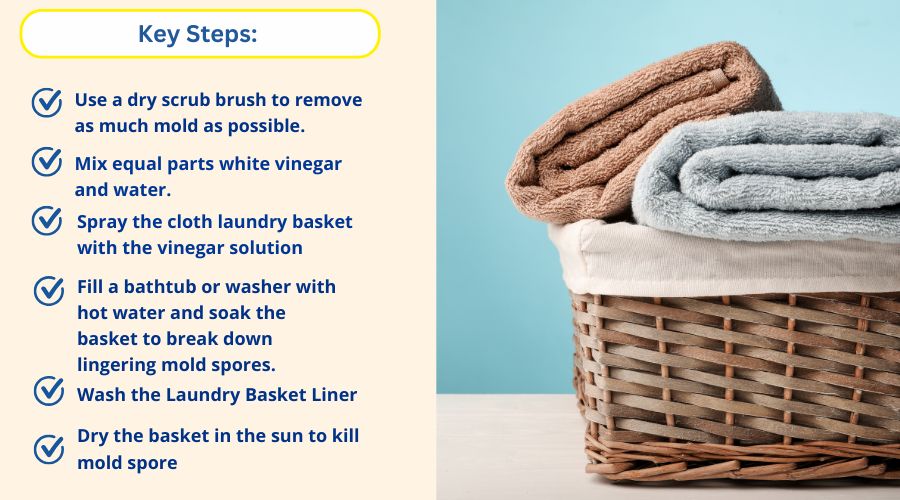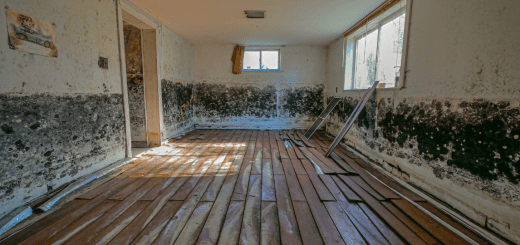Removing Mold from Places You Store Laundry

The laundry basket may carry not only dirty clothes, but microscopic organisms known as moldMold is a type of fungus that grows in damp or humid conditi... More. SporesSpores are microscopic reproductive units of fungi or mold t... More thrive in places that store laundry because they provide ample nutrients. Removing the moldMold is a type of fungus that grows in damp or humid conditi... More from these areas is critical to preventing the spread of indoor moldMold is a type of fungus that grows in damp or humid conditi... More and preserving health.
Why does mold grow in laundry hampers?
MoldMold is a type of fungus that grows in damp or humid conditi... More belongs to the fungiFungi are a group of organisms, including mold, mildew, and ... More kingdom and is present throughout the natural environment. Outdoors, the sporesSpores are microscopic reproductive units of fungi or mold t... More feed off of decaying organic matter, such as dry leaves and dead trees, breaking them down. Moist places with abundant oxygenOxygen is a chemical element essential for combustion and li... More are the perfect habitat for moldMold is a type of fungus that grows in damp or humid conditi... More.
Indoors, however, moldMold is a type of fungus that grows in damp or humid conditi... More should be eliminated. Despite being an unwanted nuisance, moldMold is a type of fungus that grows in damp or humid conditi... More sporesSpores are microscopic reproductive units of fungi or mold t... More can grow inside places that provide a consistent source of moisture. Laundry baskets, and other areas laundry is regularly stored, give moldMold is a type of fungus that grows in damp or humid conditi... More the nourishment they need to survive and thrive.
Places that hold laundry are moist, due to the clothes being drenched in sweat or the bath towels having been recently used. This moisture is just one of three nutrient sources moldMold is a type of fungus that grows in damp or humid conditi... More sporesSpores are microscopic reproductive units of fungi or mold t... More require to multiply. An organic food source and oxygenOxygen is a chemical element essential for combustion and li... More round out the spores’ requirements for nourishment.
The typical laundry basket provides moldMold is a type of fungus that grows in damp or humid conditi... More with an assortment of food: moisture from wet clothes; an organic food source from the dirt, dust and body oils found on clothing; and oxygenOxygen is a chemical element essential for combustion and li... More. The lavish banquet found in places laundry is commonly stored invites moldMold is a type of fungus that grows in damp or humid conditi... More sporesSpores are microscopic reproductive units of fungi or mold t... More.
Washing the clothes and towels stored in the laundry basket removes the moisture source from the damp materials as well as the organic food source. MoldMold is a type of fungus that grows in damp or humid conditi... More sporesSpores are microscopic reproductive units of fungi or mold t... More may look elsewhere for their next feast. However, the sporesSpores are microscopic reproductive units of fungi or mold t... More may linger if the laundry basket itself offers plenty of nourishment.
Cleaning areas where laundry is stored will effectively remove the moldMold is a type of fungus that grows in damp or humid conditi... More. Laundry shelves, including fabric ones, and laundry cabinets should be regularly cleaned to prevent moldMold is a type of fungus that grows in damp or humid conditi... More. Maintaining the places laundry is stored is as important as laundering the clothing inside.
How is mold removed from cloth laundry bags?

Removing existing moldMold is a type of fungus that grows in damp or humid conditi... More starts with scrubbing off as much moldMold is a type of fungus that grows in damp or humid conditi... More as possible with a dry scrub brush. Perform this task outside where ventilationVentilation is the process of exchanging or circulating air ... More is optimum. The last thing a homeowner wants to do is spread the airborne moldMold is a type of fungus that grows in damp or humid conditi... More sporesSpores are microscopic reproductive units of fungi or mold t... More to other areas inside the home.
Spray the cloth laundry basket with equal parts white vinegar and water. Vinegar features antibacterial and antifungal properties, making it an effective way to kill many types of moldMold is a type of fungus that grows in damp or humid conditi... More sporesSpores are microscopic reproductive units of fungi or mold t... More. Saturate any visible moldMold is a type of fungus that grows in damp or humid conditi... More stains with the solutionA solution is a homogeneous mixture of two or more substance... More. Allow the basket to soak for five minutes.
Next, a full soak in a bathtub or washer filled with one cup of vinegar and hot water breaks down any lingering moldMold is a type of fungus that grows in damp or humid conditi... More sporesSpores are microscopic reproductive units of fungi or mold t... More. Prior to this step, read the care instructions on the laundry basket to determine the temperature of water required for cleaning.
Wash the laundry basket liner in the washing machine along with a heavy-duty laundry detergent. A powerful detergent will break down the enzymes in the moldMold is a type of fungus that grows in damp or humid conditi... More sporesSpores are microscopic reproductive units of fungi or mold t... More or stains. If the laundry basket cannot be laundered, hand wash it using a spongeA sponge is a porous material used to absorb liquids or clea... More soaked in warm water and detergent.
Dry the cloth laundry basket in the sun, where the rays will kill off the moldMold is a type of fungus that grows in damp or humid conditi... More sporesSpores are microscopic reproductive units of fungi or mold t... More. Along with brightening the fabric, the sunlight removes moldMold is a type of fungus that grows in damp or humid conditi... More stains. Lingering moldMold is a type of fungus that grows in damp or humid conditi... More stains can be lightened with a spritz of lemon juice and then leave the basket in the sun to dry.
How are laundry baskets kept clean?
Routinely cleaning the laundry basket will keep moldMold is a type of fungus that grows in damp or humid conditi... More infestations at bay. Plastic hampers can be hand washed outside with hot, soapy water and rinsed clean. Dry the hamper in the sun. Make sure the hamper is fully dry before tossing clothes into it.
Clean a wicker laundry basket by vacuuming it inside and out. Mix one gallon of warm water with one cup of baking soda and scrub the basket using a soft brush. Clean between cracks, wipe with a wet cloth and dry with a towel. Complete the dryingDrying is the process of removing moisture from materials, s... More under the sun.
How is mold in laundry baskets prevented?
Damp clothes sitting inside a dark hamper create the perfect breeding ground for moldMold is a type of fungus that grows in damp or humid conditi... More colonies. Prevent moldMold is a type of fungus that grows in damp or humid conditi... More invasions by washing the clothes regularly. MoldMold is a type of fungus that grows in damp or humid conditi... More develops quickly, often within 24 to 48 hours; so, it is important to avoid leaving dirty clothes in the hamper for extended periods.
Another way to mold-proof the laundry basket is to dry wet materials, like towels, before throwing them into the hamper. Clean the laundry basket at the same time the clothes are laundered. Cloth laundry baskets can be thrown in with the load of laundry. Wipe down laundry shelves regularly.
MoldMold is a type of fungus that grows in damp or humid conditi... More growing inside places where laundry is stored can be unnerving. The sporesSpores are microscopic reproductive units of fungi or mold t... More spread rapidly, making bigger moldMold is a type of fungus that grows in damp or humid conditi... More invasions a likely threat. As soon as you see or smell moldMold is a type of fungus that grows in damp or humid conditi... More inside your property, consult mold remediation experts.

Crews of IICRC certified technicians will pinpoint all hidden and visible moldMold is a type of fungus that grows in damp or humid conditi... More growth using advanced technology. MoldMold is a type of fungus that grows in damp or humid conditi... More can be sneaky, growing behind walls, under carpets and beneath wallpaper. The equipment and techniques used ensure that all traces of moldMold is a type of fungus that grows in damp or humid conditi... More are found and eliminated.
MoldMold is a type of fungus that grows in damp or humid conditi... More requires moisture to survive. Specialists locate the water source feeding the moldMold is a type of fungus that grows in damp or humid conditi... More growth and repairRepair is the act of fixing or restoring damaged property, m... More it. Once the moisture problem is resolved, the moldMold is a type of fungus that grows in damp or humid conditi... More issue can be corrected. Another integral part of moldMold is a type of fungus that grows in damp or humid conditi... More cleanup services is to repairRepair is the act of fixing or restoring damaged property, m... More and restore moldMold is a type of fungus that grows in damp or humid conditi... More damaged goods.
It is important to address a moldMold is a type of fungus that grows in damp or humid conditi... More problem as soon as possible so that it does not have an opportunity to spread. MoldMold is a type of fungus that grows in damp or humid conditi... More growth compromises a building’s structural integrity by eating away at the organic materialsOrganic materials are derived from living organisms, such as... More. It also causes a range of health problems to the home’s occupants. Professional mold cleanup efforts will return your property to a mold-free condition.












